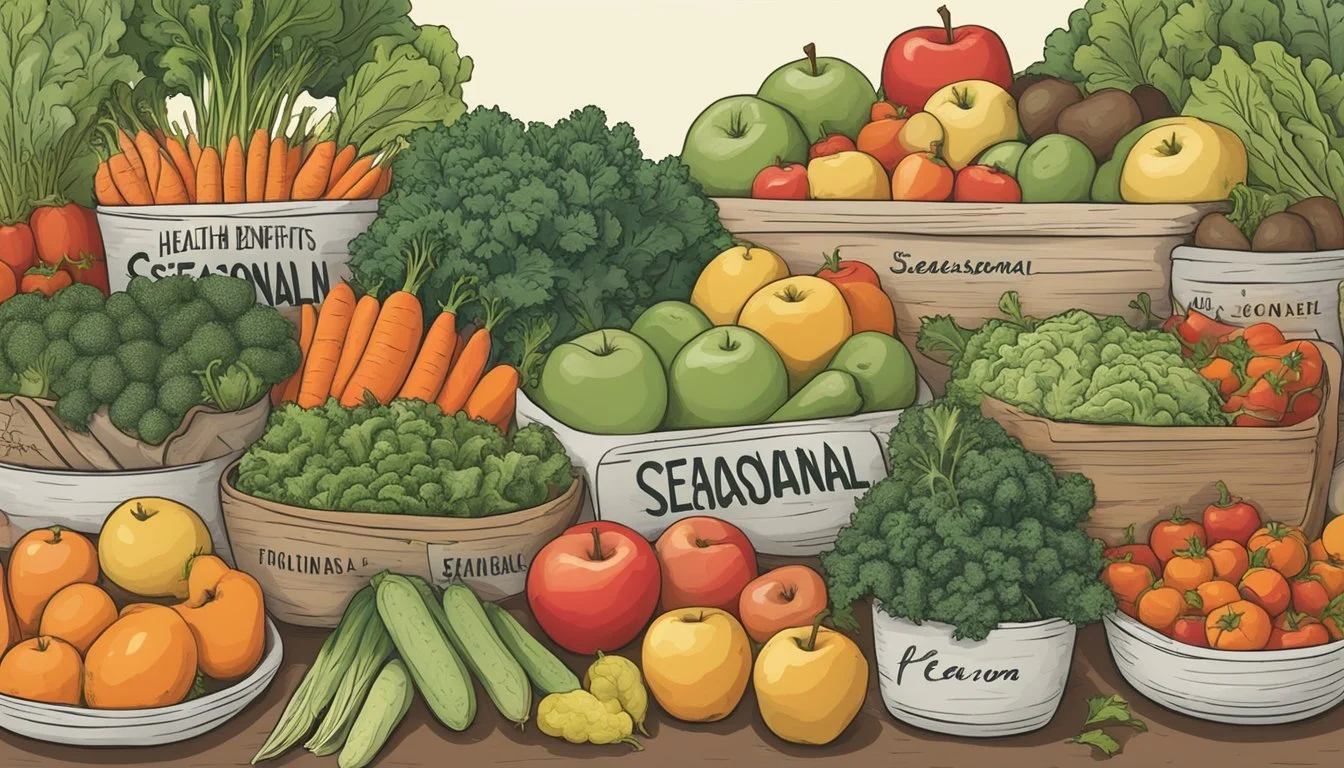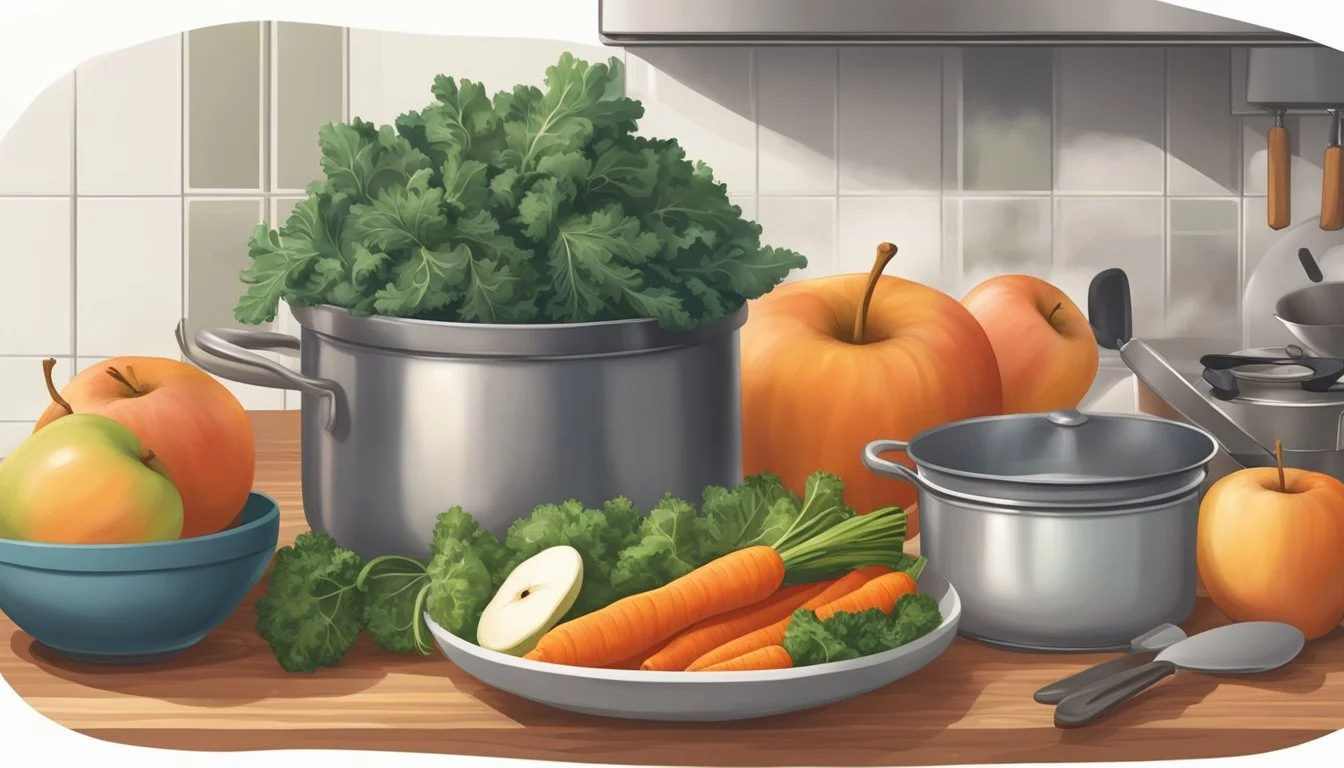Iowa Seasonal Fruit & Vegetables in January
A Guide to Fresh Produce Selection
This Article is Part of our Iowa Seasonal Fruit & Veg Calendar
In January, the fields and orchards of Iowa rest under the blanket of winter, marking a traditionally quieter time in the agricultural calendar. However, that doesn't mean fresh produce is entirely scarce. Dedicated local farmers and certain storage techniques ensure that some fruits and vegetables remain available for consumers seeking freshness even in the coldest months. Seasonal selections during this time focus on hardy storage crops and some greenhouse-grown produce.
Vegetables like sweet potatoes, onions, and carrots (how long do carrots last?), which store well, remain staples in the Iowa diet during January. Cruciferous vegetables such as broccoli and cauliflower also maintain their quality when stored properly and may be available. Turnips and winter squash offer versatility in cooking, from hearty stews to baked dishes, catering to the comfort food season.
For fruits, options are limited in comparison to the abundance of the warmer months. Apples, stored from the fall harvest, commonly retain their crispness and flavor, while the availability of imported citrus fruits like oranges and lemons adds a burst of freshness to the winter palette. These fruits also provide an essential source of vitamins, crucial for maintaining health during the flu season. Despite the challenges of the season, Iowa's January produce manages to sustain the local food scene with a modest but vital selection of fruits and vegetables.
Seasonal Cycles and Local Agriculture
Understanding the seasonal cycles of agriculture is crucial for selecting fresh produce in Iowa. During the winter months, local farmers adapt to the cold climate to harvest crops that are in season and at their peak.
Understanding Seasonality
Seasonality refers to the times of year when certain fruits and vegetables are at the peak of their freshness and flavor. In Iowa, as in other states, seasonality is influenced by local climate conditions, which dictate the types of produce that can be grown and harvested throughout the year. The knowledge of these cycles is essential for consumers seeking the freshest local produce, as well as for restaurants looking to create seasonally inspired menus.
Winter: A time when growth slows, and traditional field harvesting is minimal.
Other Seasons: Contrast with warmer months when a wider variety of fruits and vegetables are readily available.
Iowa's Winter Produce
Even during the coldest months of winter in Iowa, consumers can enjoy a selection of fresh produce that is in season. Local farmers utilize various methods, such as greenhouses and indoor growing facilities, to extend the availability of some crops beyond their traditional outdoor growing season.
Typical Winter Produce:
Root vegetables: Such as carrots (how long do carrots last?) and parsnips, which can endure the frosty weather.
Hardy greens: Including kale (What wine goes well with kale?) and spinach, which can be cultivated in cold-resistant varieties.
Table of Iowa's Winter Produce:
Vegetable Harvest Timeframe Notes Carrots Winter Available from storage Parsnips Winter Sweeter after first frost Kale Winter Can tolerate frost Spinach Winter Grown in cold frames or greenhouses
Local farmers play a significant role in providing fresh, in-season produce to their communities during Iowa's winter. This limited yet valued selection offers a taste of local agriculture at its most resilient.
Winter Fruits and Vegetables
In January, Iowa's seasonal produce includes a hearty selection of root vegetables and robust leafy greens that can withstand the cold climate. These winter favorites offer both nutrition and flavor to the season's dishes.
Root Vegetables in Focus
Root vegetables thrive in Iowa's winter, storing nutrients and energy in their roots during cooler weather.
Carrots: Packed with vitamin A, carrots maintain their sweetness and crunch in winter.
Potatoes: A staple in many diets, potatoes are versatile and rich in potassium.
Parsnips: These offer a sweet, nutty flavor and can be roasted or mashed.
Winter Squash: Varieties like butternut and acorn squash provide a comforting texture and taste.
Onions: Essential for flavor, onions are available in several varieties, each lending a distinct zest to dishes.
Beets: High in fiber and antioxidants, beets add vibrant color and sweet earthy notes.
Rutabaga: Often overlooked, rutabaga offers a bitter-sweet taste that pairs well with other winter fare.
Cruciferous Vegetables and Leafy Greens
These vegetables are known for their health benefits, including vitamins, minerals, and fibers that support overall wellness.
Kale: A nutrient-dense superfood, kale is versatile and can be used in salads, soups, and smoothies.
Cabbage: Cabbage holds up well in the cold and is perfect for slaws and soups.
Brussels Sprouts (how long do brussels sprouts last?): High in vitamins C and K, these sprouts can be roasted to reveal a nutty sweetness.
Collards: Similar to kale, collards are durable and can be braised or added to hearty stews.
Chard: Offering a milder flavor, chard is excellent sautéed or as a bright addition to pastas and grains.
Spinach: Spinach retains its delicate sweetness when cooked lightly, contributing to a variety of healthy meals.
Health Benefits of Seasonal Eating
Eating fruits and vegetables specific to the season can offer enhanced nutritional benefits and support overall health. Winter harvests, particularly in Iowa, yield produce that is not only fresh but also packed with essential vitamins and antioxidants.
Nutritional Value of Winter Harvest
The winter months in Iowa still provide a bounty of produce, and consuming these seasonal offerings can lead to higher nutrient intake. Cruciferous vegetables like kale and Brussels sprouts are prime examples of winter harvest that retain their nutritional quality even in colder climates. These vegetables are not only robust in colder weather but also a great source of fiber, vitamins, and minerals.
Kale:
Vitamins: A, C, K
Minerals: Iron, Calcium
Antioxidants: Beta-carotene, quercetin
Brussels Sprouts:
Vitamins: C, K, B
Minerals: Manganese, Potassium
Antioxidants: Kaempferol
Vitamin C Rich Produce
Citrus fruits such as grapefruit, lemons, and oranges are at their peak in January and are notably rich in vitamin C. This key vitamin boosts the immune system, which is particularly beneficial during the winter months when people are more susceptible to colds and flu. In addition, these citrus fruits contain flavonoids, a type of antioxidant that contributes to overall health and can help combat oxidative stress.
Grapefruit:
Vitamin C: Provides daily recommended intake
Health Benefits: Supports the immune system, reduces risk of chronic diseases
Lemons/Oranges:
Vitamin C: High concentration
Health Benefits: Enhances iron absorption, improves skin health
Storing and Preserving Produce
In Iowa, January marks a time of preservation where proper storage is crucial for extending the shelf life of winter produce. Maintaining the freshness of vegetables such as celery root, turnips, cabbage, potatoes, and squash requires specific storage techniques to keep them firm and flavorful.
Effective Storage Techniques
For winter vegetables, temperature and humidity control are paramount. Celery root and turnips benefit from being stored in cool, humid conditions, ideally within a root cellar or refrigerator crisper. They are best kept in perforated plastic bags to allow air circulation without drying out. Cabbage, with its hardy nature, can last for several weeks when stored in a cold, moist environment at temperatures just above freezing.
Potatoes should be kept in a dark, cool, and well-ventilated space to prevent sprouting and maintain firmness. It is important to keep potatoes away from onions as they can speed up the degradation process. Squash, on the other hand, prefers a slightly warmer storage space, around 50-60°F (10-15°C), with low humidity. A cool basement often serves as an ideal location.
Extending Freshness
Extending the freshness of vegetables is achievable with the right approach. Wrapping vegetables tightly can prevent dehydration and wilting. For instance, wrapping celery root or turnips in damp paper towels before placing them in bags can retain moisture and crispness. It's also important to inspect stored produce periodically and remove any items that show signs of spoilage to avoid affecting the rest.
Regularly consuming vegetables and rotating stock ensures that none surpass their shelf life. When properly managed, the methods highlighted above can keep your winter produce fresh for optimal taste and nutrition until the next harvest season arrives.
Cooking with January Produce
January in Iowa offers a bounty of seasonal produce that can inspire warmth and comfort during the cold winter months. Hearty root vegetables and robust citrus fruits are at the forefront, providing ample opportunities for creative and nutritious cooking.
Seasonal Recipes and Preparations
Iowa's January produce allows for a wide range of recipes, from vibrant salsas to nurturing soups. Chefs can utilize the brightness of citrus, like oranges and lemons, to add a fresh twist to dishes. A simple citrus salsa combining segments of these fruits with herbs and a hint of jalapeño can elevate grilled meats (What wine goes well with grilled meats?) or serve as a refreshing side dish.
Root vegetables such as sweet potatoes, carrots, and beets lend themselves to a variety of preparations. Roasting these vegetables with a drizzle of olive oil and a sprinkle of salt can intensify their natural flavors. For a more substantial dish, they can be transformed into soups, with additions like onions and stock enhancing their earthy tones.
Winter Comfort Foods
The cold Iowa January is the perfect time for baking and roasting, activities that not only warm up the kitchen but also result in satisfying comfort foods. Baking a casserole with layers of sliced root vegetables, cheese, and herbs can be a comforting and hearty meal. Dishes such as these capitalize on the depth of flavor that root vegetables absorb during slow cooking methods.
Roasting is ideal for a range of January produce. It yields tender, caramelized vegetables that can serve as the foundation of winter meals. Items like broccoli and cauliflower, when roasted, become nutty and rich—a perfect accompaniment to a roast or as a standalone dish seasoned with a bit of garlic and pepper.
Supporting Iowa's Local Economy
Purchasing locally-grown fruits and vegetables in January directly supports Iowa's farmers and reinforces the state's agricultural economy. This choice benefits both the community and local agriculture.
Why Choose Locally Grown Produce?
Freshness and Nutrition: Locally sourced produce is often fresher than its imported counterparts, leading to better flavor and nutritional value. When consumers choose local options, they are investing in produce that hasn't lost time-sensitive vitamins during long-distance transport.
Economic Benefits: Money spent on local produce stays within the state, contributing to Iowa's economy. Supporting local farmers means supporting local businesses that depend on agricultural success, creating a positive financial cycle within the community.
Community and Agricultural Impact
Job Creation: The choice to buy local sustains jobs in the community. Both the farming sector and ancillary businesses such as local retailers benefit.
Preserving Farmland: Investing in local agriculture helps in maintaining Iowa's farmland for future generations. By creating a market for locally grown produce, buyers ensure that farming remains a viable profession in the state.
Educational Opportunities: Awareness and support of local agriculture can lead to educational programs aimed at teaching about sustainable agriculture and nutrition, informing the community about the value and processes involved in local farming.
In January, leveraging the economic power of local purchases empowers Iowa's growers and has a multiplicative effect on its economy.







